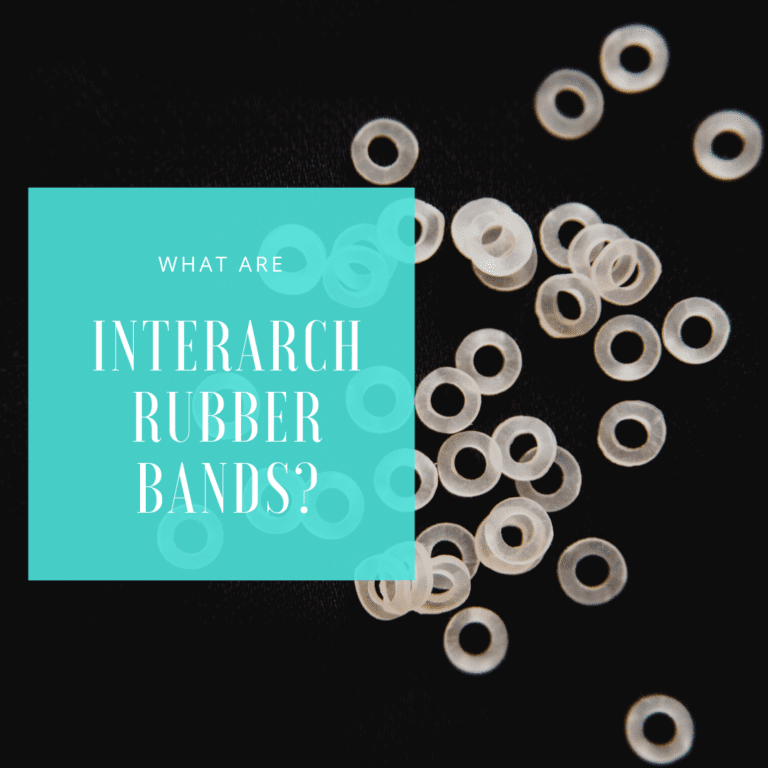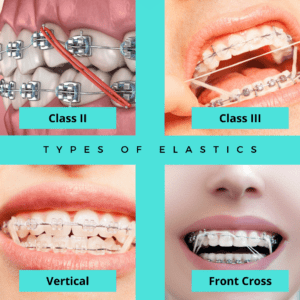What Are Interarch Rubber Bands?

Orthodontists have a variety of appliances that they can use to straighten your teeth and align your bite. Two of the most popular orthodontic appliances are fixed metal braces and removable clear aligners. However, sometimes these appliances may need a little extra help to obtain the desired results. In the case of Invisalign, this additional help comes from SmartForce Attachments. If you have metal braces, however, your orthodontist may opt to use rubber bands.
What are orthodontic rubber bands?
While metal braces correct the alignment of your teeth, orthodontic rubber bands are used to correct the alignment of your bite and jaw. These bands span across both the top and bottom arches. For this reason, they are aptly called interarch rubber bands. It is important to note that interarch rubber bands are different from other types of rubber bands and cannot be substituted.
How do interarch rubber bands work?
Simply stated, interarch rubber bands apply excess pressure to the upper or lower arch in order to gradually reposition the jaw. They are commonly used to correct malocclusions such as overbites, underbites, crossbites, and open bites. Depending on the type and severity of the malocclusion, interarch rubber bands can be positioned to obtain different results. In fact, the different types of rubber bands are classified based upon what they correct. For example, class II elastics correct overbites, class III elastics correct underbites, vertical elastics keep the teeth together, and front cross elastics correct midline alignment.

Class II elastics are used to correct overbites. They span from the lower first molar to the upper canine tooth.
Class III elastics are used to create underbites. They are arranged in a pattern that is opposite from class II. That is, they span from the lower canine to the upper first molar.
Vertical elastics are usually arranged in a triangular pattern spanning from the upper canine to the lower canine and first premolar.
Front cross elastics span from the upper canine on one side of the mouth and connect to the lower canine on the opposite side of the mouth.
Depending on the type of elastic being used, there are also different sizes of elastics that your orthodontist may recommend. While the type of elastic determines the type of movement, the size of the elastic will determine the amount of force being applied. Different positions require different amounts of force, therefore your orthodontist will have you use the best type and size of elastic to achieve the desired results. This is why orthodontic elastics cannot be substituted with other types of rubber bands.
How do I put on and take off rubber bands?
If your orthodontist is having you use rubber bands, then they will place tiny hooks on the necessary brackets. These hooks make it easy to attach and remove rubber bands from your braces. Your orthodontist may also provide you with a plastic hook that you can hold and use to place your elastics. During your appointment, your orthodontist will explain exactly how to put in and take out your rubber bands. They will also let you try to make sure you can do it and answer any questions you may have.
It is important that you follow your orthodontist’s instructions regarding rubber band wear. In most cases, you can expect to wear your rubber bands full-time at first and then only at night once the desired results have been obtained. Not wearing rubber bands as directed can result in inadequate movements, which will elongate treatment.
As you can see, interarch rubber bands can be an essential part of your orthodontic treatment used to correct malocclusion. Depending on the type of malocclusion present, there are different types and sizes of rubber bands that may be used to achieve the desired results. However, they can only be entirely effective if they are worn as directed by your orthodontist. Although rubber hands can be annoying, they will bring you one step closer to a perfect smile.
 Dr. Massih attended UCLA, where she graduated Magna Cum Laude with a degree in psychobiology. She then went on to earn her DDS degree at UCLA’s School of Dentistry, where she was awarded the Dean’s Scholarship, and was in the top 10% of her class. She has received her certificate in Orthodontics and Dentofacial Orthopedics at the University of Pittsburgh and is a member of the American Association of Orthodontists, Pacific Coast Society of Orthodontists, & American Dental Association.
Dr. Massih attended UCLA, where she graduated Magna Cum Laude with a degree in psychobiology. She then went on to earn her DDS degree at UCLA’s School of Dentistry, where she was awarded the Dean’s Scholarship, and was in the top 10% of her class. She has received her certificate in Orthodontics and Dentofacial Orthopedics at the University of Pittsburgh and is a member of the American Association of Orthodontists, Pacific Coast Society of Orthodontists, & American Dental Association.

Recent Comments